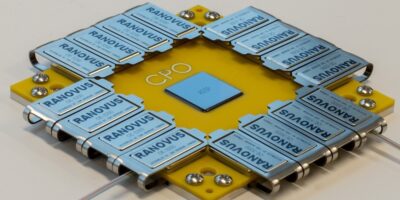Silicon photonic engine prepares for increased data traffic
Preparing for multi-Tbit co-packaged optics for compute, storage and networking, Ranovus has introduced the Odin 8 single chip silicon photonic engine to support machine learning (ML) and artificial intelligence (AI) workloads for data centres and 5G.
“ML/AI are the driving forces behind innovation in our society. They have created new compute, storage and networking paradigms inside and outside the data centre,” said Hamid Arabzadeh, chairman and CEO at Tbit interconnect company, Ranovus.
“The massive growth in data traffic fuelling the algorithms requires scalable and power efficient networking technologies. Odin platform delivers 50 per cent power consumption/Gbit per second reduction and 75 per cent cost/Gbit per second reduction over today’s solutions,” he continued.
Odin scales Ranovus’ 100Gbits per second per lambda silicon photonics engine from 800Gbits per second to 3.2Tbits per second in a single chip supporting both module and co-packaged optics.
The Odin platform incorporates the company’s disruptive multi-wavelength quantum dot laser (QDL), 100Gbits per second silicon photonics based micro ring resonator modulators and photo detectors, 100Gbits per second driver, 100Gbits per second transimpedance amplifier (TIA) and control ICs supported by a Tier 1 packaging ecosystem.
The Odin 8 silicon photonics engine has the lowest power consumption/Gbits per second and cost/Gbits per second in the industry, claims Ranovus. It supports ML/AI applications with 0.4 nanosecond low latency and protocol agnostic engine and supports transmission distance of 10 metres to 2km in CWDM and DWDM applications.
There are eight optical channels of 100Gbits per second/64Gbits per second/50Gbits per second PAM4 or 50Gbits per second/32Gbits per second/25Gbits per second NRZ.
It also supports QSFP-DD and OSFP module form factors and 25.6Tbits per second and 51.2Tbits per second Ethernet Switch configurations.
“Intra-data centre traffic is growing at a rate that outpaces anything seen outside of the data centres and is expected to triple in the next five years, said John Martinho, senior vice president R&D at Ranovus.
“This growth in traffic is driving global energy consumption, for power and cooling, that is simply not sustainable at the current trajectory,” he said, explaining the reason for the introduction of the optical engine platform.
Ranovus develops and manufactures advanced solutions for the next generation of interconnects for the telecommunications and information technology industries. The company has operations in Ottawa, Canada, Nuremberg, Germany and Sunnyvale, USA, with staff experienced in product development and commercialisation of optoelectronics components and transceiver subsystems for the information technology industry. Ranovus’ current disruptive portfolio includes quantum dot multi-wavelength laser technology and advanced digital and silic on photonics IC technologies that sets a new industry benchmark for the lowest power dissipation, size and cost for the next generation of optical interconnect solutions.




